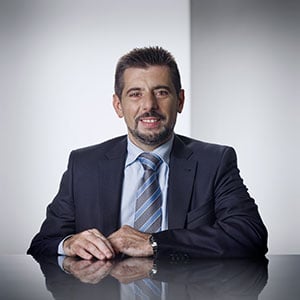

Marco Marelli,
System
Engineering Director
at Prysmian Powerlink
Prysmian Group boasts a long-standing tradition
of presence in the International Council on Large
Electrical Systems, one of the key worldwide
bodies operating in the sector. The Group’s
highly qualified and distinguished experts take
part on a regular basis in the Study Committees and Working Groups of the Council, also
contributing with technical papers. Recently the
Council, known as CIGRE, announced that Marco
Marelli, System Engineering Director at Prysmian
Powerlink, has been appointed new chairman
of CIGRE’s SC B1 (Insulated Cables), one of the
main authorities in terms of recommendations
and standards in the worldwide EHV cable
industry. In this interview, Marco describes the
mission of the body he was called to chair and
the key points of his agenda.
The International Council on Large Electrical Systems is one of the key bodies operating in the sector worldwide: what are its specific tasks and aims?
CIGRE is a permanent, non-governmental and non-profit international body with about 10,000 associates, founded in 1921 and dedicated to the development of the power supply sector through the identification and the development of solutions to industry issues. Work done by over 3,500 experts covers technical, economic, environmental, operational, organisational and regulatory aspects.
A few months ago, CIGRE published the new Strategic Plan which strengthened the focus on support for the creation and development of the electrical system of the future. The goals for the next five years will therefore be around this topic. SC B1 (Insulated Cables) can contribute by fostering the integration of HVDC in power networks, facilitating the implementation of underground structures, increasing the awareness of stakeholders on the key factors towards sustainable development. As new chairman of SC B1 (Insulated Cables) at CIGRE, what are the priorities in your agenda for year 2017?
I started my four-year term with a short message that summarises my views about the future of SC B1 and gives direction for next year.
I confirmed the centrality of the Working Bodies and the appreciation for the valuable people who deliver tangible results. Efficiency and quality in the preparation of these documents will have my full attention: already in 2017 I think we’ll have mechanisms in place to monitor the quality and time-to-market of the production of Technical Brochures.
The big change for SC B1 will, however, be around the empowerment of local experts in their own countries and regions: delegates will be the ears and the voice of the Study Committee and the many local experts will act as ambassadors of SC B1.
The cable industry is already highly regulated. Do you think the current framework in Europe is strict enough to guarantee the needed standards in terms of safety and quality? And what about the rest of the world? Where do you see the need for regulatory action?
The new European CPR - Construction Products Regulation - is a significant step ahead in this direction. This is one of the most advanced sets of regulations for both safety and quality, but my business experience in High Voltage and Submarine and my exposure to a geographically wide market mean it’s easy to see the gaps. There are still many under-regulated countries and regions, in particular for those large projects and special works that happen too rarely to be covered by local standards.
Then, CIGRE could help with international recommendations about safety issues, as happens already for performance-related aspects. I took the initiative to include ‘Safety, Health, Environmental and Quality considerations for cable systems’ as a topic for discussion for the next CIGRE B1 General Session in 2018. Most important, I’d like to engender within CIGRE the idea that SHEQ regulations and standards are not hindering but fostering innovation.
What role does innovation play within the cable industry?
Innovation has both a commercial and social impact. The world today is continuously dealing with issues about environment, safety, accessibility to resources for everybody, social acceptance, sustainable growth, and so on. I believe that innovation affects all of these issues, and I think this applies in the cable industry too.
Here are just a couple of examples. One is about advanced monitoring systems and innovative policies for asset management. They may extend the concept of smart grids to large power networks, thus making for more efficient and safe use of power cables. Another example involves HVDC cable systems. Different and significant innovations in insulation materials have been fundamental in the increased use of interconnectors and development of offshore wind generation far from the coast in northern Europe. Both applications are bringing about better use of renewable energy, with a positive impact on carbon footprint, job creation and economic sustainability.
CIGRE 2016 came at a very important time for Prysmian, as it followed announcements of the successful qualification of the most advanced technologies in the field of insulation materials for HVDC cable systems, such as 525 kV HPTE (P-Laser), 600 kV XLPE and 700 kV MI PPL. Which one gained the most of the attention and why?
P-Laser. No doubt! In fact all three innovations attracted attention and questions.
The 700 kV voltage level is definitely not common and can be considered a market niche, and our MI PPL cable has been seen as the confirmation of Prysmian’s historical leadership in paper-based insulation systems.
Many people were looking for XLPE DC cable developments, expecting few manufacturers to be capable of reaching the 525 kV level. Announcing our 600 kV qualification and showing cable samples gave the perception of a company able to ‘do more’ than its competitors.
But most people were interested in the 525 kV P-Laser. Our customers appreciated the higher thermal and electrical performance of this insulation, in particular for HVDC, and are ready to consider P-Laser cables as a viable option when planning new power links.